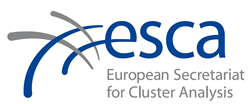Cluster Management Excellence
Clusters are complex and dynamic structures that are subject to continuous change. Strong clusters can promote economic growth through leveraging the innovation and business potential of a region. New employment opportunities, new products and services, new companies, new R&D activities and new patents can be the result of activities within a cluster. Moreover, cluster organisations can be powerful vehicles to identify and address new (mega)trends and act as agents of change for industrial modernisation, regional economic development or entrepreneurship acceleration. For example, clusters can be used as a strategic tool to facilitate the uptake of advanced technologies, digitalisation, new business models, low-carbon and resource-efficient solutions, creativity and design, social economy, etc.
A professional cluster management can contribute to such a development through projects and services that tap into the cluster's potential. The European Cluster Excellence Initiative (ECEI), which was initiated by the European Commission DG Enterprise and Industry in 2009, developed methodologies and tools to support cluster organisations to improve their management capacities and capabilities. The 13 project partners of the European Cluster Excellence Initiative invented a uniform set of cluster management quality indicators and developed a quality labeling system featuring the three quality labels BRONZE, SILVER and GOLD for professional cluster management.
 |  |
|---|
The European Cluster Excellence Initiative has become a clear success story with the benchmarking and labelling scheme being extensively used in numerous countries. As of today, more than 1,100 cluster organisations from 45 countries have been benchmarked and/or awarded a BRONZE label, around 130 a SILVER label and more than 100 a GOLD label, respectively. Today, cluster managers and policy makers alike recognise the three ECEI quality labels as a credible “International standard for cluster management”.
A review of the entire labelling system within the framework of the European Cluster Excellence Initiative – Phase II (2017-2019), which was again supported by the European Commission, resulted in a further development of the governance and management system of the labelling scheme. Main features of the new labelling system are increased transparency, efficiency and the strengthening of the European dimension of the cluster labelling.
Another new feature is the introduction of a new set of so-called Eligibility Criteria: Organisations that are interested in obtaining a quality label must prove their status as a “Cluster Organisation” as defined by the European Commission by fulfilling the set of “Eligibility Criteria for Cluster Management Excellence Labels”.

